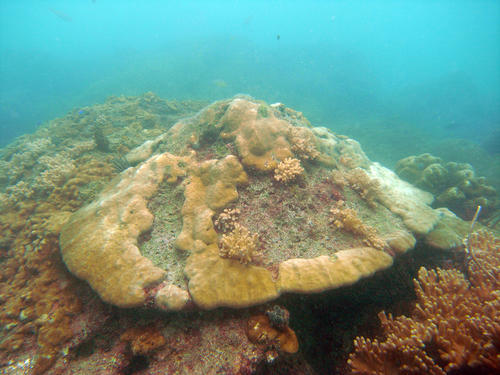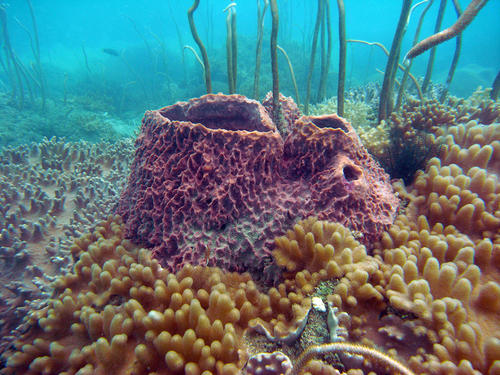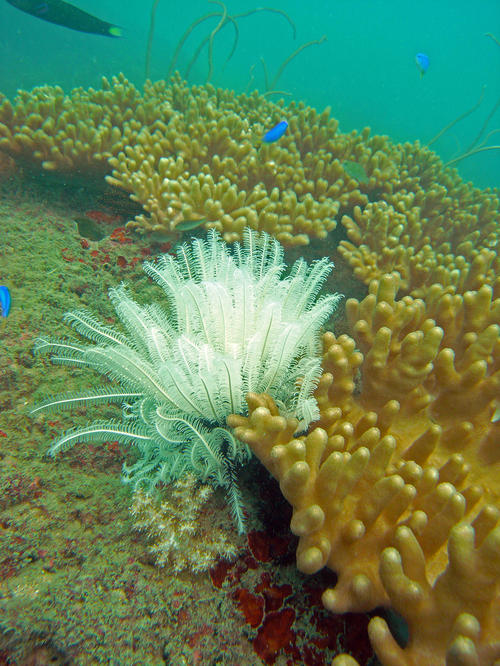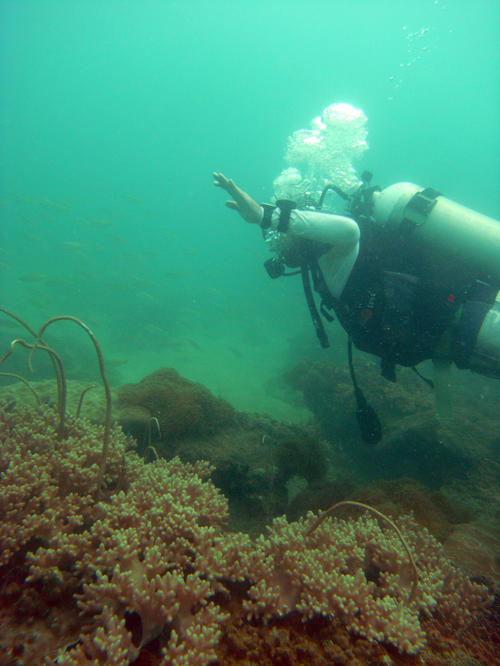A geospatial assessment, long term monitoring and environmental reconstruction of marine habitats within the Miri-Sibuti Coral Reefs National Park
Inshore Reefs Eve's Garden (© Curtin University)
Inshore Reefs Eve's Garden (© Curtin University)
Inshore Reefs Eve's Garden (© Curtin University)
Inshore Reefs Eve's Garden (© Curtin University)
News vom 11.09.2016
Video (on YouTube): "The Curtin Baram Project"
Video (on YouTube): "Curtin Marine Science in the Miri-Sibuti Coral Reefs National Park"
The Curtin Sarawak Research Institute
Department of Environment and Agriculture
Curtin University
Bentley, WA 6102
Australia
Department of Applied Geology
Curtin University Sarawak
98009 Miri, Sarawak
..........................................
Kontakt
Dr. Jens Zinke
Freie Universität Berlin
Fachrichtung Paläontologie
Malteserstrasse 74-100 - Haus C
Raum C.105
D-12249 Berlin
+49 (0)30 - 838 61034
jzinke@zedat.fu-berlin.de
..........................................
Introduction
The tropical marine fauna diversity in South East Asia, particularly that off Sarawak East Malaysia has been described as ‘greater than any other on earth’ (Carpenter and Niem, 1998) and is considered one of the world’s biodiversity “hot-spots” (Shabdin, 2014). The coastline of the largest state Sarawak, which extends approximately 1035 km, lies within the Indo-Malay-Philippine archipelago, and is located on the northern side of the Island of Borneo. This area of coastal reefs sustains a rich assemblage of marine life including fish, corals, molluscs, crustaceans and marine mammals (Shabdin, 2014).
In recognition that the vulnerable coral reef systems needed preserving, the Miri-Sibuti Coral Reefs National Park (MSCRNP) with a total size 186,930 ha was gazetted in February 2007. While the primary objective was that of protection, other goals included the development of local eco-tourism ventures. As a consequence the MSCRNP is fast becoming a well-known dive location, offering a range of experiences including access to coral reefs, wreck dives and a decommissioned oilrig, which is Malaysia’s first artificial reef. However the true economic potential of the MSCRNP is yet to be quantified, in part because the type, range and extent of various marine habitats within the marine park have not been accurately mapped and assessed.
The MSCRNP is both Sarawak’s first marine park and its largest. It is currently classified as ‘totally protected’ meaning all forms of commercial activities that can impact the ecological state of the marine environment are banned. The only permitted activities are boating, recreational diving and snorkelling. The efficacy of enforcement within MSCRNP is currently unknown as enforcement was only recently introduced in 2013 (Yeo, 2013). It is fair to assume, therefore, there may be some prohibited activities occurring, given the large size of the marine park and the history of enforcement in no take marine zones in the past (Sethi and Hilborn, 2008; Tupper et al., 2015). Additionally, Southeast Asia has experienced fast urbanisation during the past 30 years that was accompanied by accelerated deforestation, which had reached very high levels in the region in previous decades (Langner et al., 2007; Langner and Siegert, 2009; Miettinen et al., 2011; Hansen et al., 2013). The legacy problems associated with deforestation on the marine environment will be both quantitatively and qualitatively investigated.
Our current knowledge of marine habitats within the marine park comes from a small number (6) of Reef Check sites that have been monitored since 2009. The site data reveals that while coral cover has remained relatively stable in the past five years, there has been a decline in exploited reef fish species over the same period. To fill a significant knowledge gap we propose a detailed and extensive hydrographic survey of the offshore waters of MSCRNP to create up-to-date and comprehensive maps of the various benthic communities. Detailed habitat maps will be used to identify key sites where a baseline survey will be undertaken of the coral, fish and invertebrate assemblages. Some of these sites will be marked permanently and revisited on an annual basis as part of a long-term monitoring program. Quantifying coral cover, composition and diversity will give some insight into the resilience of reef communities to seasonal sedimentation from the adjoining river system. A reconstruction of the environmental history of the MSCRNP will be done using coral coring and advanced geochemistry techniques.
Collaborative research between Curtin University’s Department of Environment and Agriculture in Perth, Australia and the Curtin Sarawak Research Institute at the University’s Sarawak campus involves the following four inter-disciplinary projects:
1. Spatial mapping of marine habitats within the MSCRNP
2. Baseline and long-term surveys of the MSCRNP
3. Efficacy of the MSCRNP
4. Environmental reconstruction and impacts of sedimentation and climate change on reef systems in the MSCRNP
Project 4
Environmental reconstruction and the impact of sedimentation and climate change on reef systems in the MSCRNP
Project leaders
Dr Nicola Browne
Department of Environment and Agriculture
Curtin University
Dr Jens Zinke
Department of Earth Sciences
Institute of Geological Sciences, Paleontology
Freie Universität Berlin
Co-investigators
Assoc. Prof. Ramasamy Nagarajan
Department of Applied Geology
Curtin University Sarawak
Dr Iain Parnum
Centre for Marine Science & Technology
Curtin University
4.1 Background
Anthropogenic and climate-induced changes in sediment load entering the coastal realm are of great concern for the sustainability of tropical marine and terrestrial environments (Payet and Obura, 2004; Bruggeman et al., 2012; Maina et al., 2013). Deforestation often leaves soils susceptible to erosion (Green and Sussman, 1990; Agarwal et al., 2005; Miettinen et al., 2011; Hansen et al., 2013; Meijaard et al., 2013) thus altering the amount and characteristics of both sediment and leached dissolved components delivered to the coastal ocean (Warrick and Rubin, 2007; Maina et al., 2013).
The Maritime Continent which includes many humid tropical insular states in Southeast Asia has experienced fast urbanisation during the past 30 years that was accompanied by accelerated deforestation which reached very high levels in the region in previous decades (Langner et al., 2007, 2009; Miettinen et al., 2011; Hansen et al., 2013). Achard et al. (2002) showed that Southeast Asia had one of the highest annual deforestation rates (0.8%) in the 1990s. According to FAO statistics (FAO, 2006) an average yearly deforestation rate of 1.7% has been suggested in insular Southeast Asia between 1990 – 2000. Currently, reforestation at places is expected to curb sedimentation reaching the nearshore areas through various activities, but the overall success of these management activities need to be assessed.
Furthermore, climate extreme events of global importance like the El Niño conditions in 1997–1998 led to unprecedented drought and strong wild fires causing dramatic forest loss in the region. Fuller et al. (2004) estimated that Borneo Island had experienced an annualized 2.0% forest loss between 1997 and 2002, largely attributed to the 1997–1998 fires. Abram et al., (2003) showed the devastating impact of red tides following the 1998 fires that led to widespread coral mortality off Sumatra. A better knowledge of the effect and magnitude of climate change in the marine environment of the Miri-Sibuti Coral Reefs National Park and surrounding areas is needed to formulate best management strategies for sustainable use and protection of the marine resources.
MSCRNP location within the Maritime Continent and the Coral Triangle makes it an ideal location to study the combined effects of anthropogenic warming and natural interannual to decadal climate variability on the corals reefs of MSNP. The Maritime Continent is the climate engine of the Planet, its variability in hydrology and temperatures influences global atmospheric and oceanic circulation (Zinke et al., 2015). Hoell and Funk (2013) and Hoell et al., (2013) showed that during both El Niño and La Niña events the global impacts, including the Coral Triangle, in terms of SST, atmospheric circulation and precipitation, were more severe when the SST anomalies in the western Pacific and Maritime Continent were strongly opposing those in the central Pacific SST. Recently, Cai et al. (2015) showed, for a subset of CMIP5 models, a high likelihood for a more intense temperature gradient between the Maritime continent and the central Pacific and intensified La Niña events in 21st century climate projections, further highlighting the importance of studying climate variability across the Maritime Continent. MSNP is also located along the route of surface ocean transport from the North Pacific through the South China Sea towards the interior of the Maritime Continent. Currently, few marine observations or paleoclimate reconstructions are available from across the Maritime Continent, and there is a large knowledge gap in marine climate science for the region of Borneo.
Recently, Kleypas et al. (2015) mapped the sea surface temperature response to El Niño and La Niña events across the Western Pacific and Maritime Continent from satellite observations and ocean modelling over the past 30 years. The MSCRNP was found to be located in a hotspot region of strong long-term warming of ocean temperatures. Strong La Niña events following El Niño’s led to most severe bleaching across the Coral Triangle, yet heat stress at MSCRNP was lower than sites across the Philippines and Sulawesi (Kleypas et al., 2015). However, most reefs are located close to the coast where satellite SST observations are less reliable. In order to capture the heterogeneous heat stress during El Niño and La Niña events across the MSCRNP, we need to obtain reliable records from marine climate archives. To overcome this problem, paleoclimate records from coral cores can provide information on past thermal stress and long-term warming signals at the reef scale associated with regional and global climate change and variability (Zinke et al., 2014, 2015).
4.2 Key Questions
We will address three key subprojects,
1) assess spatial and temporal variability in sediment flux and water quality in the reefs, using both in situ and remote sensing techniques,
2) assessing coral response to high sediment loads and
3) reconstructing climatic and environmental baseline data for the MSCRNP from coral core geochemistry.
Specifically, the sediment cores, water samples, and sateline remote sensing will provide valuable calibration data to assess the uptake and response of corals to elevated sediment, soil derived humic acid and pollutant/nutrient levels in the water column sourced from the Baram river and adjacent smaller catchments.
As a primary objective of the Subproject 2 ‘Assessing coral response to high sediment loads’, we will determine the current coral community composition, their spatial distribution and disease prevalence in reefs sites impacted by sediments and from non-impacted control sites.
Specifically, we will develop baseline data for:
a. Disease and tissue necrosis levels of corals within the MSCRNP.
b. Assessment of community composition i.e. balance between sediment sensitive to tolerant species as a long-term response to sediment loads in the MSCRNP.
c. Seasonal changes in coral growth of selected species to sediment loads in the MSCRNP.
d. Assessment of coral acclimation to elevated sediment and nutrient loads through lipid and chlorophyll analysis
As a primary objective of the coral coring Subproject 3, we will determine natural levels of seasonal river runoff (TE; organics) and sea surface temperature signals due to climatic base level changes over the past ~100 years, foremost of inter-annual to decadal-scale variability (El Niño/La Niña) and intermittent extreme erosion events along the path of heavy monsoon weather events. As a secondary objective, we will assess anthropogenic impacts on river runoff impacting the MSCRNP as offsets from the climatic baseline levels.
Specifically, we will develop environmental baseline data for:
a. Seasonal and long-term river and sediment (soil) runoff into the MSCRNP.
b. Indo-Australian Monsoon related heavy runoff event history, detected as discrete events by spectral photoluminescence and TE analysis in corals, will show a close link to the climate phenomena such as the El Nino-Southern Oscillation (Zinke et al. 2014).
c. Coral cores from different reef areas and at varying distances from shore will provide insights into the spatial and temporal dynamics of river runoff and sea surface temperature anomalies affecting coral reefs and enable the identification of hotspots of sedimentation and thermal stress.
d. Anthropogenic effects through land use will emerge as offsets relative to climatic baseline levels, fingerprinting changing land use and runoff in the pertinent catchments. This will allow us to determine effect of long-term changes in forest cover and their impact on coral growth.
e. Sea surface temperature proxies from coral cores will reveal thermal stress history of reef corals related to either El Niño or La Niña events and Maritime Continent climate variability in concert with Indonesian Throughflow variability (Kleypas et al., 2015). This will allow us to determine the sensitivity of the corals to thermal stress.
4.3 Research Methodologies
Subproject 1
Anthropogenic land-use and climate change impacts on coral reef ecosystems potentially cause coral disease, mortality from smothering polyps, and reduced reproductive output. Therefore, this project will involve collecting sediment and water samples at various distances from the shore across a gradient of impact, and for different seasons (wet and dry season) to generate baseline data of environmental variability. A number of parameters will be measured including particle size, the presence of trace elements and nutrient content. Water samples can also potentially be used to trace fish and coral biodiversity from DNA (TrEnD lab Curtin, Mike Bunce, Michael Stat). In addition, in-situ data loggers will be deployed to measure turbidity, current flow and temperature over the course of the study. Sediment traps at numerous stations throughout the MSCRNP and towards Miri and Baram River mouth will measure sedimentation rates (Figure 4a). We will target sites with high and low impact from sedimentation (turbidity).
Within each site we will further stratify for depth, leeward/windward, aiming for four treatments per site to ensure replication. We propose:
1. Three transects per treatment
2. Three sediment traps or sediment trays – collect sediments every month
3. Three water quality and sediment samples – collect water samples every month
4. Tag and measure 5 coral colonies for at least three key coral species – used for growth, lipid analysis etc.
Deploying data loggers
1. 4 light sensors per site –download data every month
2. 1 to 2 ADCPS and turbidity sensors per reef at key sites – selected and deployed in September 2016.
Seawater samples at numerous stations along an inshore-offshore transect from the Baram delta to the MSCRNP. These water samples will be used to characterise the nutrient and suspended solid geochemical profile along the transport pathway form the land to the ocean. The aim is to identify sites within the MSCRNP that are affected by the Baram and those free from impact. Data on temporal chlorophyll‐ a concentrations as indicator of surface water productivity related to nutrient supply (9 km by 9 km grids; 8‐ day binned data available at NASA’ s Ocean Color Web, http://oceancolor.gsfc.nasa.gov/) will be obtained to support in-situ analysis of nutrients. Rainfall and river discharge data for the Baram river catchment will be taken from the regional rainfall /discharge stations.
The sediment cores and water samples will provide valuable calibration data to assess the uptake and response of corals to elevated sediment, soil derived humic acid and pollutant levels in the water column sourced from the Baram River and adjacent smaller catchments.
We also propose the use of MODIS remote sensing imagery over the Miri-Sibuti and Baram river region to add to the understanding of the distribution of sediment from the Baram River. Moderate Resolution Imaging Spectroradiometer (MODIS)-Aqua, can be used to produce maps of Total Suspended Sediment (TSS) (Dorji et al., 2016).
To produce these TSS maps requires deriving the regional relationship between TSS and band 1 of MODIS through coincidental measurement of above water radiance (for atmospheric correction) and the in situ sampling for TSS previously described (ground truth). This will enable the creation of a time series of maps covering the marine park and the mouth of the Baram River. The time series will be of the order of monthly data for the last 5 years.
Subproject 2
Assessing the effects of sediment inputs on nearshore coral communities requires a comprehensive assessment of coral cover, coral composition and coral physiological health. Baseline data on coral cover and composition, collected as part of Project 2, will provide vital quantitative data on the reef’s spatial extent and current health status. There are many naturally turbid reefs in nearshore coastal ecosystems that are characterized by high coral cover and diversity (Browne et al. 2012). Yet, these reefs are typically dominated by sediment tolerant coral species such as Turbinaria sp. and Goniastrea sp. (Anthony 2006). These corals have acclimated to low light levels, either through increasing their photosynthetic capacity or/and through enhanced heterotrophic feeding (Anthony 2000, Browne et al. 2014). Data on coral composition will determine the balance between sediment tolerant and sediment sensitive coral species, thereby provide some indication of coral community resilience to potential increases/changes to the sediment input. If such changes should occur, coral physiological health can also be monitored in situ using a range of parameters that include: photo-physiology (chlorophyll), growth and density changes, mucus production and lipid content. These parameters enable researchers to assess coral stress prior to potential coral mortality. To this am, we propose to tag and stain five coral colonies for three coral species from sediment-impacted and non-impacted sites with sufficient treatment replication. For each coral colony, we would place a see through plastic bag over the coral colony and secure the bag tightly to the base of the coral with a cable tie. Coral colonies of <30 cm diameter are preferred to prevent damage to colony when bag is placed over the top and secured. Once the bag is secured, Alizarin Red S dye is injected into the bag at a known concentration and left in place for 3-4 hours. During this time, the coral will absorb the dye and stain the carbonate skeleton under the coral tissue (Browne 2012). There is no visible change in the coral and the coral is not harmed by the dye. After 3-4 hours, the bag is removed and a tag is placed on the coral for identification later on. Sample collection will occur 5-6 months (Feb 2017) following staining and will involve removal of 3-5 fragments (<10 cm) from the stained coral. These fragments will be used to determine linear extension, density and carbonate production rates, chlorophyll and lipid content. These data would be collected in conjunction with high resolution data on SST, water quality, sediment regime (deposition/resuspension) and local hydrodynamics.
Subproject 3
To better understand the historical anthropogenic impacts, sediment and coral cores can be taken that provide a hindcast of previous sediment/nutrient profiles/signatures over the previous decades. To this aim we propose to drill long cores from living massive Porites sp. corals (Figure 4b). A commercially available pneumatic drill (Rodcraft 4500) operated by scuba will be used to extract 4-5 cm diameter cores along the central growth axis of the coral colony (Grove et al., 2010). The drill holes will be plugged with pre-fabricated concrete plugs to prevent bioerosion and to enable natural overgrowth by coral tissue within 2 years.
Records retrieved from giant corals can fill the data gap as they contain detailed and continuous geochemical fingerprints of changing hinterland erosion and sediment discharge, accumulated during centuries of rapid skeletal growth in marine river catchments (Alibert et al., 2003; McCulloch et al., 2003; Lewis et al., 2007; Grove et al., 2010, 2012, 2013; Maina et al., 2012). These coral archives can now be read using novel, spectral photoluminescence imaging of entire cores (Grove et al., 2010), combined with state-of-the-art trace element and isotope analysis (McCulloch et al., 2003; Sinclair and McCulloch, 2004; Grove et al., 2012). Runoff events are manifested in corals as narrow luminescent growth bands due to incorporation of humic acids leached from hinterland soils and by low-density calcification of the skeleton (Fig. 5; Barnes and Taylor, 2001; Lough & Cantin, 2014; Grove et al., 2010). Riverine sediments also contain adsorbed barium, manganese, rare earth elements and other trace elements that are desorbed when entering the low-salinity region of the estuarine mixing zone. Subsequently, both humic acids and trace metals behave as conservative dissolved constituents that inshore corals incorporate into their carbonate skeleton in concentrations proportional to the ambient seawater and thus runoff (McCulloch et al., 2003). Next to river runoff, changes in sea surface temperature can be traced by analyzing coral Sr/Ca ratios (Fig. 4; Grove et al., 2013; Zinke et al., 2014). Stable isotopes of oxygen and carbon can reveal changes in salinity and dissolved inorganic carbon delivery (Grove et al., 2012). We will analyse the nitrogen isotopes in coral cores (δ15 Ncoral ) from selected reef sites to examine whether the δ15Ncoral reflects the run-off of nitrate related to the land use in the Baram river catchment (Yamazaki et al., 2014). This will help us to assess if the seasonal variation in nitrogen istopes from nitrate inflow by the Baram River is related to rainfall and discharge variability as well as vegetation change (land-use) in the hinterland. Coral linear extension, density and calcification will be determined from X-ray-based densitometry studies (Lough & Cantin, 2014). The down-core analyses of coral trace elements (TE), stable isotopes and humic acids (called geochemical proxies) in long coral cores can provide information on site-specific temporal variability in sea surface temperature, salinity, river flow, organic and sediment loads influencing coral growth parameters (Grove et al., 2013; Lough & Cantin, 2014). This technique has been successfully used to trace periods of forest loss in Madagascar and Indonesia and to study impacts of subsequent management intervention to curb deforestation and sediment delivery (Abram et al., 2003; Maina et al., 2012; Bruggemann et al., 2012; Grove et al., 2013). As natural long-term monitors of dynamic environmental conditions, cores drilled from giant corals allow for detailed investigation of climatic and anthropogenic changes on their own and in unison. Such information can assist in the management of watersheds impacting the Miri-Sibuti Marine Park where instrumental data on water characteristics and temporal change are lacking.
All geochemical facilities to undertake this work are available at Curtin University supported through the John de Laeter Centre for Isotope Research (HR-ICP-MS) and the Laser Ablation ICP-MS facility (Applied Geology). X-ray imaging of coral cores is available through the Department of Medical Radiation Sciences at Curtin. Coral image analysis and densitometry is available through collaborations with the Australian Institute of Marine Science (Townville, Queensland). UV luminescence scanning is available through collaborations with the Royal NIOZ (Netherlands). Stable Isotopes can be measured at the West Australian Biogeochemistry Centre at UWA in Perth and at Freie Universitaet Berlin (Germany). Nitrogen isotope analysis can be carried out in collaboration with Hokkaido University and/or the Leibniz Institute at the Humboldt Museum Berlin.
4.4 Project Outcomes
To effectively address the problem of mangrove and coral reef degradation resulting from land-based activities and regional/global climate change, scientific data that would convince the community and policy makers alike to undertake best conservation action are required. Our results will provide new insights into the role of global climate change on heat stress in MSNP’s coral reefs and hydrological signals affecting Borneo through river runoff changes. Furthermore, we will be able to assess which sites in the MSCRNP are affected by the Baram River sediment and nutrient outflow. Often, the scientific know-how and basic laboratory requirements are lacking in the most severely affected areas. This project launches a truly collaborative effort between partner institutions CSRI and Curtin and international research teams. This project provides important data to assess the historical and anthropogenic changes and provides knowledge through research and education to regional scientists. More independent research efforts of our partner institutions will result from such pioneering, ice-breaking international collaborations that may have enormous societal benefits. Finally, our research projects include training of regional scientists at CSRI Miri Campus in state-of the-art monitoring of seawater, coral and sediment properties, with access to analytical facilities and free availability of data to directly support local management activities in the river catchments studied.



